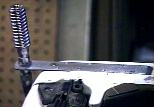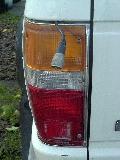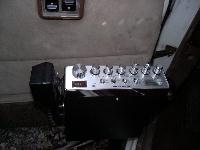CB Antenna and Radio Installation
Contents:
Back to my Cheap Tricks main page.
![]()
Introduction:
When I first installed my CB radio, I made use of a matching transformer to allow sharing of the AM/FM antenna with the CB. While this worked reasonably well it had some drawbacks. First, it was not a very good antenna, and being mounted close to the engine, picked up lots of noise. Then it also required the antenna to be extended for use which is not a good idea when overhanging branches threaten to tear it off. So, I picked up up a 4' FireStik-II antenna and decided to mount it on the rear tire carrier frame. When installed on my rear tire rack, I had the antenna tuned (to 1.2 SWR) and it worked fine. After a few months my transmit quality was down and I assumed the radio was going out on me). My antenna had a decent ground (at DC) but at RF, I think it was more like an open. My SWR was over 3, adding a heavy ground conductor only brought it into the high 2's.
To digress a bit into RF signal propagation theory, what an antenna really likes to see is a conductive plane at ground potential (a ground plane) stretching off to infinity below it in all directions. My 4Runner isn't quite that big, but my tire carrier rack is even smaller. The largest expanse of relatively horizonal metal in the 4Runner is the body, so by mounting the antenna in contact with the body is the best solution. Since the shell on the 1st generation 4Runner is non-conductive fiberglass, this large surface is not useable as is.
[Return to the top of this page]Antenna Mounting:
Anyway, fellow 4Runner owner Scott Wilson had a nice antenna setup for his '88 4Runner and I modified his design for my needs. Since I had the shell off for the summer, it was easy to do this installation.
Basically, with the shell off, I sanded the paint off a section of the left rear corner, outside the raised area where the shell gasket mounts to. I used 1"x 1/8" steel bar stock, cut to length and riveted to the body. I also inserted one 1/4" pan-head bolt for added strength.
- UPDATE:
- After about 4 years of use, the 1/8" hot rolled steel finally succumbed to metal fatigue and snapped off. I replaced it with some stainless steel plate to make it a bit stiffer and more resistant to fatigue. I also added a rubber bumper at the base to limit the flexing of the bracket.
The antenna cable (18' of coax) is routed down the body panels, inside the vehicle, and it exits through the driver's side taillight grommet. Instead of drilling holes in the sheet metal, I simply filed a small notch in the top the the tail light assembly for the cable to fit. This way, you don't need to make a big hole for the coax connector to fit through. The remainder of the coax cable is inside the driver's side body panel, loosely laid inside, not coiled.
[Return to the top of this page]CB Radio:
Well with this cool, and powerful new CB antenna, I soon found my poor AM/FM/CB radio combo was overwhelmed with noise on the CB. This antenna was pulling in so much skip and what not that I couldn't hear the guy talking 100 feet down the trail. With CB radios, they all pretty much transmit the same, all federally regulated to 4W or so. What you pay for in a CB is the receiver. A poor receiver and a poor antenna works OK, as it only hears local signals. mixes of good and poor don't work, but the best bet is a good antenna and an equally good receiver. I found a re-conditioned Uniden Grant-XL on their web site. They were out of stock, but I placed a reservation and a few weeks later one came in, so I grabbed it, $129 instead of nearly $300 new. It was a big chassis, all discrete components (i.e. transistors, capacitors, inductors, none of that wimpy IC crap). Had real knobs that turned real switches with real contacts. And when you turn the power off and on, it remembers the previous settings, all without any battery backup (i.e. the channel selector stays in the same position).
Only trouble was the size, this thing was huge. Taking the web page dimensions, it looked like it would fit in the console below the factory radio cutout. Close, but no cigar. Some folks have hung CBs from the roof (sunroof and map lights were already there) or under the seat (CD changer was there), but I saw a fit on the door. I had the stock map pocket, but it was easily moved to be in the way of the passenger's feet and the CB bracket was soon taking its place. This puts the mic in handy reach, its fairly out-of-the-way and is handy to reach through the rolled down window, too. I fooled with the wiring for a long time, before finally running it through the grommets in the door for the light and power window wiring. This eliminated all the trouble I had with wires breaking from the constant open-close cycles. This all came back to the reason the radio was "re-conditioned" in the first place. It turns out, upon closer examination, the power connector pins had a cold solder joint on the main PC board. They measured OK, but vibration or stress on the connector would cause them to open. I'll bet someone had trouble with the unit, returned it, it checked out fine on the test bench (it always did for me) and it was sold as a re-furb.
Since resolving that problem, I'm really happy with this radio. It has a number of very cool features including:
- RF Gain - Controls the sensitivity of the receiver, I use this as a much better squelch control, I open the squelch all the way, turn the gain up only enough to hear local traffic and the radio is totally silent unless someone is transmitting.
- The Squelch is softer than my old CBs, instead of an abrupt threshold (that lets in everything) this one slowly opens, however I rarely use it.
- Noise blanking (NB) and automatic noise limiting (ANL), work great, keep out all the engine noise, etc. I turn 'em both on and leave it that way.
- Mic gain and transmit power help keep from blasting the "ears" off of others in the group. I run with low power and high mic gain most of the time.
- Built-in SWR-Calibration meter is handy to check on the antenna connection. SWR does change, and this way you can keep tabs on it. For example, after a day on the ocean dunes at Pismo Beach, I found my antenna match was off, turns out the salt in the sand dust made a conductive film on the antenna, changing its properties. Quick wipe of a rag and it was good as new.
- Single-side-bad (SSB) is neat. It allows more power (12W) so you can talk farther (if someone is listening). May come in handy one day, fun to play with on the interstate. But not just a toy, SSB rigs have to have better receiver circuitry, so you get a better radio with SSB than without.
- PA (Public Address) is one feature I have not used, an external speaker placed outside or under the hood would be required.
Time for a Smaller Radio:
After many years of use, I decided to replace the Uniden GrantXL radio. I had an in-cab roll cage to install and the down-tube needed to go down where the radio was. I tried to find a place to move it to, but could not find anywhere to put it where it was both convenient to access and out of the way. So, I opted for a remote-mount Cobra 75 radio. It has a tiny little electonics/connector module that houses the transmitter and then everything else resides in the microphone. It also has weather band and can scan and monitor multiple channels, which were some features I had been looking for. The electronics module fit neatly next to the cruise control module in the driver's side kick panel. Hooked up power, ground and antenna cables from my old radio and it was ready to go.
I did however find that my SWR reading was in the 3.0+ range, very high. After doing some parts swapping (old/new radio, two different antennas) I narrowed the problem down to a bad antenna cable. Replaced that and I was back down to 1.1 or 1.2 SWR. Much better for transmit range. Still working on a location for the microphone.
[Return to the top of this page]Power for CB radios and noise prevention:
So, you have your new CB radio installed and you find you can hardly hear anything due to the static noise. What to do about that? Simple, CB radios pick up anything electrical within their frequency range. They don't care if that signal comes in through the antenna or in through the power and ground connections or through their case. If you only want to hear what comes in over the antenna, you need to make sure as little noise comes in through the other ways. In my case, I found the best way to power my CB radio was with a dedicated power AND ground wire. If I hooked up to some existing vehicle circuit (like the radio or cigarette lighter circuit), I picked up all sorts of static. Also, if I connected the CB radio chassis ground to any random part of sheet metal, I also got lots of noise.
A simple test of this is to turn your CB radio on without the engine running and compare the incoming noise to that when the engine is running. If the noise is worse when the engine is on, then you have noise from the running engine getting into the CB. What sorts of noise could this be? You have an alternator on the engine, it is an AC voltage generator and inside it are diodes that rectify that AC voltage to DC voltage for the battery. This creates noise. Assuming an engine with spark plugs, you have high voltage going to those plugs and they are firing many thousands of times per second, that is noisy. And on a computer controlled engine, you have a computer and fuel injectors and other devices running at various frequencies, and that electrical noiser can get into the CB radio.
So on my '85 4Runner, what I did to minimize the noise was to run the dedicated wires as noted above. Why? Well, think of your power and ground wires as a big loop antenna. Anything inside that loop of wire will be picked up and fed into the CB radio power lines. In order to minimize the "size" of that "antenna", I ran both power and ground wires (fused at the battery) from the battery back along the passenger side of the engine bay (away from the alternator and spark plugs) and twisted those wires as they ran. Then inside the cab, I installed an active noise filter and then ran both power and ground wires to the CB. By twistng the power and ground wires, you are keeping them tight together to eliminate any way for noise to get in between them (just like the twisted pair wires in your ethernet cable). Plus by bring a power and ground connection back to the radio, you are eliminating any chance of "ground loops" which can occur if you ground to some sheet metal in the cab and then rely on some circuitous path back to the battery where there can be other ground currents flowing.
So with good clean power to the CB, you stand the best chance of getting a good quiet signal on receive. However, the one thing you can't control is how well shielded the CB radio itself is. I had one CB originally that was not shielded well and no matter what I did, it picked up a lot more nosie with the engine running than with it off. So I replaced that with a higher quality radio and had no issues with engine noise. In fact I took that old radio and put it in my VW diesel and guess what, it worked fine. Diesels have no ignition or computer and without the external sources of noise, it was nioce and quiet. Well at least until a gas engine vehicle would pull up beside me on the road and then that radio would get noisy again.
[Return to the top of this page]
![]()
[Initial Creation: 01.OCT.1998]
Visitor # 94899 since 28.AUG.2001
[Last updated: 22.March.2021]




